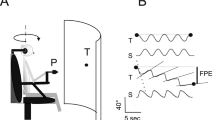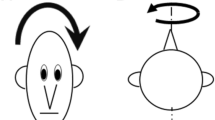Abstract.
A control systems model of the vestibulo-ocular reflex (VOR) originally derived for yaw rotation about an eccentric axis (Crane et al. 1997) was applied to data collected during ambulation and dynamic posturography. The model incorporates a linear summation of an otolith response due to head translation scaled by target distance, adding to a semi-circular canal response that depends only on angular head rotation. The results of the model were compared with human experimental data by supplying head angular velocity as determined by magnetic search coil recording as the input for the canal branch of the model and supplying linear acceleration as determined by flux gate magnetometer measurements of otolith position. The model was fit to data by determining otolith weighting that enabled the model to best fit the data. We fit to the model experimental data from normal subjects who were: standing quietly, walking, running, or making active sinusoidal head movements. We also fit data obtained during dynamic posturography tasks of: standing on a platform sliding in a horizontal plane at 0.2 Hz, standing directly on a platform tilting at 0.1 Hz, and standing on the tilting platform buffered by a 5-cm thick foam rubber cushion. Each task was done with the subject attending a target approximately 500, 100, or 50 cm distant, both in light and darkness. The model accurately predicted the observed VOR response during each test. Greater otolith weighting was required for near targets for nearly all activities, consistent with weights for the otolith component found in previous studies employing imposed rotations. The only exceptions were for vertical axis motion during standing, sliding, and tilting when the platform was buffered with foam rubber. In the horizontal axis, the model always fit near target data better with a higher otolith component. Otolith weights were similar with the target visible and in darkness. The model predicts eye movement during both passive whole-body rotation and free head movement in space implying that the VOR is controlled by a similar mechanism during both situations. Factors such as vision, proprioception, and efference copy that are available during head free motion but not during whole-body rotation are probably not important to gaze stabilization during ambulation and postural stabilizing movement. The linearity of the canal-otolith interaction was tested by re-analysis of the whole body rotation data on which the model is based (Crane et al. 1997). Normalized otolith-mediated gain enhancement was determined for each axis of rotation. This analysis uncovered minor non-linearities in the canal-otolith interaction at frequencies above 1.6 Hz and when the axis of rotation was posterior to the head.
Similar content being viewed by others
Author information
Authors and Affiliations
Additional information
Received: 11 March 1998 / Received in revised form: 1 March 1999
Rights and permissions
About this article
Cite this article
Crane, B., Demer, J. A linear canal-otolith interaction model to describe the human vestibulo-ocular reflex. Biol Cybern 81, 109–118 (1999). https://doi.org/10.1007/s004220050548
Issue Date:
DOI: https://doi.org/10.1007/s004220050548




